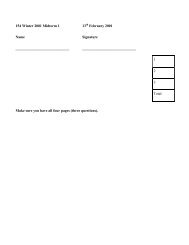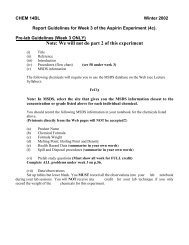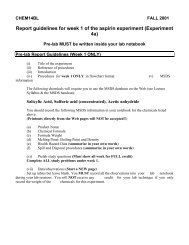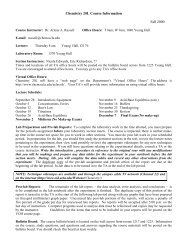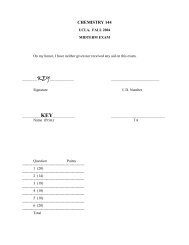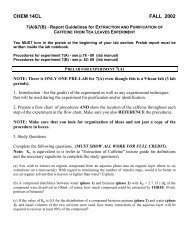Extraction and Purification of Caffeine from Tea Leaves
Extraction and Purification of Caffeine from Tea Leaves
Extraction and Purification of Caffeine from Tea Leaves
You also want an ePaper? Increase the reach of your titles
YUMPU automatically turns print PDFs into web optimized ePapers that Google loves.
CHEM 14CL SPRING 2006<br />
<strong>Extraction</strong> <strong>and</strong> <strong>Purification</strong> <strong>of</strong> <strong>Caffeine</strong> <strong>from</strong> <strong>Tea</strong> <strong>Leaves</strong><br />
IMPORTANT: Make sure that you follow the proper laboratory safety protocol (refer to the course syllabus) BEFORE<br />
going to the lab. You will be dismissed <strong>from</strong> the laboratory if you do not follow the proper safety protocol.<br />
ONLINE RESOURCES AND TUTORIALS<br />
PRE-LAB REPORT GUIDELINES<br />
Theory in <strong>Extraction</strong> (Real Player Video)<br />
<strong>Extraction</strong> Tutorial<br />
Thin Layer Chromatography (TLC) Tutorial<br />
Pre-lab report must be written inside your lab notebook.<br />
IMPORTANT: Make sure that you always follow the proper laboratory safety protocol (refer to the course<br />
syllabus) BEFORE going to the lab.<br />
NOTE: There is ONLY ONE pre-lab report for this experiment even though this is a 9-hour lab (3 lab periods).<br />
1. Introduction - list the goal(s) <strong>of</strong> the experiment as well as any experimental techniques that will be used during<br />
the experiment for purification <strong>and</strong>/or identification.<br />
2. Flowchart - Prepare a flowchart <strong>of</strong> procedures AND show the location <strong>of</strong> the caffeine throughout each step <strong>of</strong> the<br />
experiment in the flow chart. Make sure you also REFERENCE the procedures.<br />
NOTE: Make sure that you look for organization <strong>of</strong> ideas <strong>and</strong> not just a copy <strong>of</strong> the procedure in boxes.<br />
3. Study Questions<br />
Complete the following questions. (MUST SHOW ALL WORK FOR FULL CREDIT).<br />
Note: Kp is equivalent to α (refer to lecture guide for definitions <strong>and</strong> the necessary equations to complete the<br />
study questions).<br />
(a) You wish to extract an organic compound <strong>from</strong> an aqueous phase into an organic layer (three to six extractions on a<br />
marcoscale). With regard to minimizing the number <strong>of</strong> transfer steps, would it be better to use an organic solvent that<br />
is heavier or lighter than water? Explain.<br />
(b) A compound distributes between water (solvent 1) <strong>and</strong> benzene (solvent 2) with Kp = 2.7. If 1.0g <strong>of</strong> the compound<br />
were dissolved in 100mL <strong>of</strong> water, how much compound could be extracted by THREE 10-mL portions <strong>of</strong> benzene?
CHEM 14CL SPRING 2006<br />
<strong>Extraction</strong> <strong>and</strong> <strong>Purification</strong> <strong>of</strong> <strong>Caffeine</strong> <strong>from</strong> <strong>Tea</strong> <strong>Leaves</strong><br />
IMPORTANT: Make sure that you follow the proper laboratory safety protocol (refer to the course syllabus)<br />
BEFORE going to the lab. You will be dismissed <strong>from</strong> the laboratory if you do not follow the proper safety<br />
protocol.<br />
3. Study Questions (Continue)<br />
(c) If the value <strong>of</strong> Kp is 0.5 for the distribution <strong>of</strong> a compound between pentane (solvent 2) <strong>and</strong> water (solvent 1), <strong>and</strong><br />
equal volumes <strong>of</strong> the two solvents were used, how many extractions <strong>of</strong> the aqueous layer will be required to recover at<br />
least 90% <strong>of</strong> the compound?<br />
(d) Calculate the % <strong>of</strong> a compound that can be removed <strong>from</strong> liquid phase 1 by using ONE to FOUR extractions with<br />
a liquid phase 2. Assume that Kp = 2 <strong>and</strong> the volume <strong>of</strong> phase 2 equals to 50% that <strong>of</strong> phase 1.<br />
(e) A slightly polar organic compound distributes between diethyl ether <strong>and</strong> water with a partition coefficient equal to<br />
3 (in favor <strong>of</strong> the ether). What simple method can be used to increase the partition coefficient? Explain.<br />
4. Set up BLANK DATA tables for recording any numerical values AND in-lab observations. (Use a NEW page for<br />
the tables).<br />
IMPORTANT: You MUST record ALL the observations during the lab period for this experiment in your notebook.<br />
Failure to do so will result in no credit for your lab technique as well as part <strong>of</strong> your post-lab report.
CHEM 14CL SPRING 2006<br />
(A) Abstract<br />
Report Guidelines for EXTRACTION AND PURIFICATION OF CAFFEINE FROM TEA<br />
LEAVES EXPERIMENT<br />
POST-LAB REPORT GUIDELINES - THIS IS A GROUP REPORT<br />
Post-lab report must be written inside your lab notebook.<br />
Outline the objective <strong>of</strong> the experiment as well as any experimental results that obtained. Include any<br />
technique that you used in the lab to isolate, purify <strong>and</strong> analyze the experimental products.<br />
(B) Data, Observations <strong>and</strong> Data Analysis<br />
(i) Recopy all observations as well as numerical data in an organize manner.<br />
(ii) Use equations to help explain any chemical reactions that occur during the experiment <strong>and</strong> explain the<br />
phenomenon (physical changes) behind each step <strong>of</strong> the observation<br />
(iii) Calculate the % caffeine that you recovered <strong>from</strong> tea.<br />
(iv) Mass Spectrum <strong>of</strong> caffeine: (i) Identify the base peak. (ii) Identify the molecular ion peak. (iii) Does<br />
the molecular ion peak confirm the present <strong>of</strong> caffeine? Explain.<br />
(v) UV Spectrum <strong>of</strong> caffeine: Calculate the molar extinction coefficient (ε) for caffeine. Show all your<br />
work.<br />
Note: Assume the diameter <strong>of</strong> the cell holder to be 1 cm.<br />
Note: We will discuss mass spectroscopy later on in the course. At this point, use the following definitions<br />
to answer the questions related to mass spectrum <strong>of</strong> caffeine.<br />
Base peak is the signal on the mass spectrum that has the highest intensity with respect to the y-axis.<br />
Molecular ion peak refers to the signal on the mass spectrum that gives you the molecular mass <strong>of</strong> the<br />
sample. Simply look at the x-axis (which is the mass) <strong>and</strong> look for a signal that gives you the molecular<br />
weight <strong>of</strong> caffeine.<br />
(vi) Calculate the Rf values <strong>of</strong> BOTH the pure caffeine <strong>and</strong> the crude caffeine. Show all your work.<br />
Note: Read pages 153-162 in Mohrig (Techniques on Organic Chemistry, 1 st Edition) about the concepts in<br />
Thin Layer Chromatography (TLC). Pay special attention to pages 154-155 on how to find Rf value <strong>and</strong><br />
what it means. Concepts behind TLC will be discussed later on in the course.
CHEM 14CL SPRING 2006<br />
(C) Conclusion<br />
Report Guidelines for EXTRACTION AND PURIFICATION OF CAFFEINE FROM TEA<br />
LEAVES EXPERIMENT<br />
POST-LAB REPORT GUIDELINES - THIS IS A GROUP REPORT<br />
Post-lab report must be written inside your lab notebook.<br />
(i) Compare your % caffeine value to the reported value <strong>of</strong> about 2-4% caffeine content in tea leaves.<br />
Explain what may cause the % to be differed (i.e. where the loss <strong>of</strong> caffeine may come <strong>from</strong> during the<br />
experiments).<br />
(ii) Compare experimental IR spectrum to literature IR spectrum (provided with the experiment #14<br />
worksheets or you can download it online (see below)). What can you conclude about the purity <strong>of</strong> your<br />
experimental caffeine product?<br />
Note: If you don’t have the literature caffeine IR spectrum, go to the following Web site <strong>and</strong> download the IR<br />
spectrum:<br />
http://webbook.nist.gov/chemistry/<br />
Do a NAME search on caffeine <strong>and</strong> there should be a hyperlink for the gas phase IR spectrum <strong>of</strong> caffeine.<br />
(iii) Interpretation <strong>of</strong> caffeine product composition <strong>and</strong> purity <strong>from</strong> TLC results. Explain all your reasoning.<br />
NOTE: Before answering part (iii), refer to the notes on TLC listed on the previous page <strong>of</strong><br />
this guideline.<br />
Attach ALL the experimental spectra & the ORIGINAL experimental TLC plate with your<br />
post-lab report.




